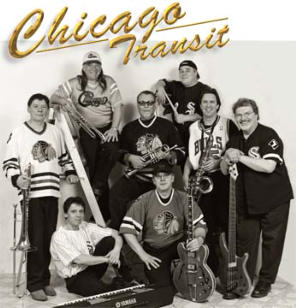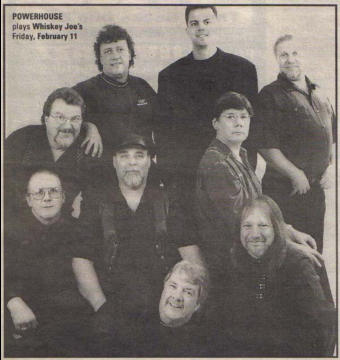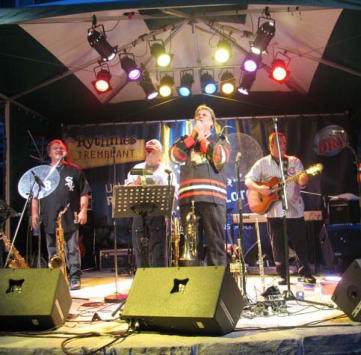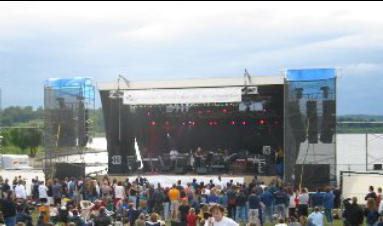







In the POWERHOUSE history, the 1990’s and early 2000’s could be called the ‘middle years’ for the band. During this time, the band evolved from the original 7-piece R&B horn unit to a multi-show 8-piece rock/horn band. The first major change for the band
band evolved from the original 7-piece R&B horn unit to a multi-show 8-piece rock/horn band. The first major change for the band came late in 1991 when the band changed trombone/horn arrangers. Due to illness, Don Berryman left the band and was replaced
came late in 1991 when the band changed trombone/horn arrangers. Due to illness, Don Berryman left the band and was replaced by Dan Elliot, a trombonist two years senior to Don in the same high school music program. With Dan, not only came extremely
by Dan Elliot, a trombonist two years senior to Don in the same high school music program. With Dan, not only came extremely competent trombone playing, but also excellent ‘horn arranging’ abilities. This set the stage for the next 15 years of
competent trombone playing, but also excellent ‘horn arranging’ abilities. This set the stage for the next 15 years of POWERHOUSE, a time when the band moved into different, much more complex musical areas.
POWERHOUSE, a time when the band moved into different, much more complex musical areas.
 band evolved from the original 7-piece R&B horn unit to a multi-show 8-piece rock/horn band. The first major change for the band
band evolved from the original 7-piece R&B horn unit to a multi-show 8-piece rock/horn band. The first major change for the band came late in 1991 when the band changed trombone/horn arrangers. Due to illness, Don Berryman left the band and was replaced
came late in 1991 when the band changed trombone/horn arrangers. Due to illness, Don Berryman left the band and was replaced by Dan Elliot, a trombonist two years senior to Don in the same high school music program. With Dan, not only came extremely
by Dan Elliot, a trombonist two years senior to Don in the same high school music program. With Dan, not only came extremely competent trombone playing, but also excellent ‘horn arranging’ abilities. This set the stage for the next 15 years of
competent trombone playing, but also excellent ‘horn arranging’ abilities. This set the stage for the next 15 years of POWERHOUSE, a time when the band moved into different, much more complex musical areas.
POWERHOUSE, a time when the band moved into different, much more complex musical areas.
The next major change for the band came a year or so later, when a friend of the band, Vince Rinaldo, sat in one night with
his keyboard. Up to this time, the band instrumentation was the four horns with just guitar, bass and drums in the rhythm
section. Obviously, the addition of a keyboard player to the 7-piece unit went over very well, and Vince became part of the
band. This set the stage for the next major changes in the band – or probably more accurately, additions to the band.
Once the keyboard parts were
added to the band, it was decided
to try a couple of Chicago Transit
Authority songs in the show. The
band’s drummer, Paul Vardy, had a
‘natural’ Peter Cetera voice – so
essential in doing any cover tune
from the Chicago band. With
Paul’s voice, the four-piece horn
section, and Dan Elliot’s horn
arrangements, the Chicago tunes
went over very well with the band.
At this point, the band made the
decision to do a full Chicago
Transit tribute show to accompany
their regular Powerhouse show.
By the mid-90’s, Powerhouse had
a Chicago Transit show, the first of
its kind, with full sanctioning from
the original Chicago band.
The mid 90's version of the band.
Clockwise, from top: Martin Kling, Brad Stone,
Dan Eliot, Carlo DiBattista, Glen Higgins, Phil
Kott, Greg Smith, Paul Vardy and the only
original left, John Willett, in the centre.
The Powerhouse CD from the mid-90's -- a
collection of R&B covers, some Chicago material
and an original written by Steve Negus, the
drummer. And yes, there are still some available.
The next project started when a friend of
the band, Dave Battah, came by one
night and suggested that the band back
him in his Rod Stewart Tribute
Show. Dave was one of the best
around at impersonating Rod,
having already toured the world
with his act, so the band started
to work again – this time learning
a full Rod Stewart show. Once
this was done and the band was
now performing with Dave as
well as their two other shows,
another friend of the band by,
Frank Rondell. Many of the guys knew Frank from the 60's. Now, Frank was
known as “The Best” Ray Charles impersonator and following a short band
meeting, the band was at work again – this time, learning a full Ray Charles
show. By the time the millennium rolled around, the band had four complete
shows in their repertoire, and as band members came and left the band, the
new-comers were finding that, with nearly 100 songs now in their shows, coming
'on-board' and learning the band’s material was becoming a fairly large task.
These were good years for the band, with many personnel changes as members would join,
leave, and rejoin as the band’s live show schedule got heavier and heavier. The band was
playing festivals, corporate gigs, bars, theatres and you-name-it all over eastern Canada
and the U.S.A. In Ontario, they played the Waterfront Festival in Belleville, Cayuga
Speedway, The Festival of the Islands in Gananoque, The Fish Fest and Friday the 13th
bash in Fort Erie, Canada Day Festivals in Newmarket, Woodstock and Brantford and at the
C.N.E. in Toronto a few times. They did ski resort shows at Mont Tremblant in Quesbec and
Blue Mountain in Ontario. Down in the states, they played at the Southside Summerfest in
Port Huron, in Bay City and in Chicago as their alter-ego, Chicago Transit. The band spent
these 'middle years' adding shows to their portfolio and improving musically, and with that,
so were the venues that they were playing.














1991-2004








